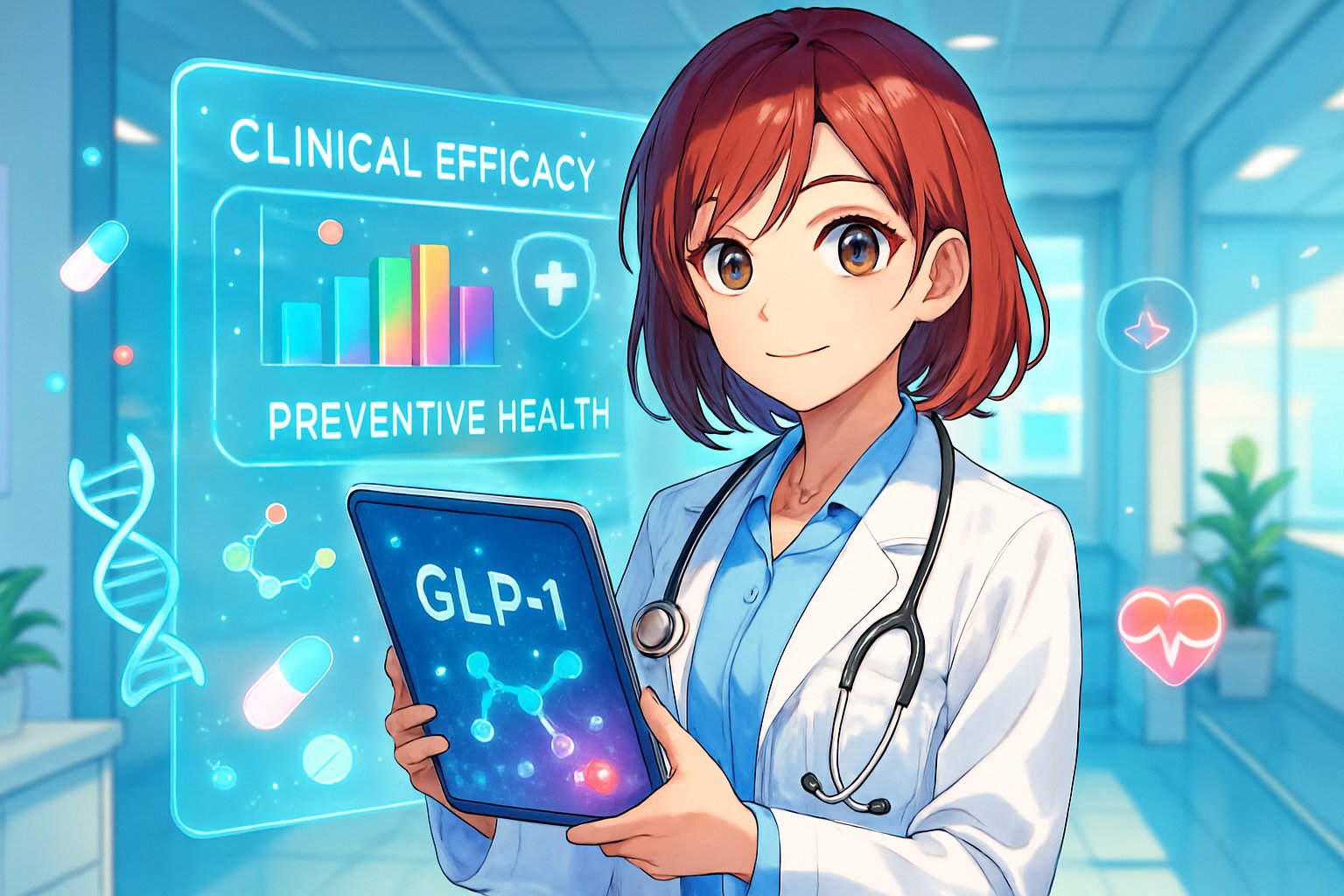GLP-1 receptor agonists have evolved far beyond their original role in diabetes management. These medications now represent a powerful tool for preventing cardiovascular disease, managing obesity, and addressing multiple health risks before they become serious problems.

Clinicians can now use GLP-1 agonists as first-line preventive treatments for patients with obesity or cardiovascular risk factors, even without diabetes. Recent clinical trials show these drugs reduce heart attacks, strokes, and death rates while helping patients lose significant weight. The European Society of Cardiology now recommends GLP-1 receptor agonists in their prevention guidelines.
Understanding how to select the right patients, adjust doses, and monitor for side effects will help clinicians maximize the preventive benefits of these medications. The shift from treating disease to preventing it represents a major change in how healthcare providers can protect their patients’ long-term health.
Key Takeaways
- GLP-1 agonists work as preventive tools for heart disease and obesity, not just diabetes treatment
- Patient selection should focus on cardiovascular risk factors and weight status rather than blood sugar alone
- Proper dosing strategies and safety monitoring help clinicians achieve the best preventive outcomes for patients
Role of GLP-1 Agonists in Preventive Health

GLP-1 agonists work through multiple pathways to prevent disease before symptoms appear. These medications reduce cardiovascular risk through direct vessel protection and metabolic improvements, while early intervention in prediabetes can prevent progression to type 2 diabetes.
Mechanisms of Action in Disease Prevention
Glucagon-like peptide-1 receptor agonists activate GLP-1 receptors throughout the body, not just in the pancreas. This activation triggers protective mechanisms in blood vessels, the heart, and other organs.
The medications improve insulin sensitivity in muscle and fat tissue. They also reduce inflammation markers that contribute to chronic diseases. GLP-1 receptor activation in the brain helps control appetite and food intake.
Key Protective Mechanisms:
- Enhanced insulin secretion when blood sugar rises
- Reduced glucose production by the liver
- Slower stomach emptying to prevent blood sugar spikes
- Direct anti-inflammatory effects on blood vessels
- Improved fat metabolism and reduced liver fat storage
Research shows these drugs have beneficial effects on liver, kidney, and cardiovascular health through both direct tissue effects and indirect metabolic improvements. The GLP-1 receptor is found in many organs, explaining why these medications affect multiple body systems.
Impact on Cardiovascular Risk Reduction
Clinical trials demonstrate that GLP-1 agonists significantly reduce heart attacks, strokes, and cardiovascular death. These benefits occur even in patients without diabetes.
The cardiovascular benefits happen through several pathways. The drugs lower blood pressure and improve cholesterol levels. They also reduce inflammation in blood vessel walls and help prevent dangerous blood clots.
Major Cardiovascular Benefits:
- 13-14% reduction in major heart events
- Lower risk of heart attack and stroke
- Reduced cardiovascular death rates
- Improved blood vessel function
- Better blood pressure control
Studies show significant reductions in cardiovascular events and mortality, making these drugs important tools for heart disease prevention. The protection extends beyond blood sugar control to direct heart and blood vessel benefits.
Weight loss from these medications also reduces strain on the heart. Every 10 pounds of weight loss can lower systolic blood pressure by 5-20 mmHg.
GLP-1 Agonists for Prediabetes and Early Intervention
Prediabetes affects 88 million Americans, with most unaware of their condition. GLP-1 agonists can prevent or delay progression to type 2 diabetes in high-risk individuals.
Early treatment with these medications preserves pancreatic function. The drugs protect insulin-producing cells from damage caused by high blood sugar and inflammation. Starting treatment before diabetes develops maintains better long-term blood sugar control.
Benefits of Early Intervention:
- 40-70% reduction in diabetes development risk
- Preserved pancreatic beta cell function
- Greater weight loss when started earlier
- Lower lifetime healthcare costs
- Reduced risk of diabetes complications
Research supports early use of GLP-1 receptor agonists to reduce the lifetime burden of chronic diseases on both patients and the healthcare system. The approach focuses on prevention rather than treating established disease.
Patients with prediabetes who use GLP-1 agonists often achieve normal blood sugar levels. This reversal of prediabetes can last for years after stopping the medication, especially when combined with lifestyle changes.
Patient Selection and Clinical Guidelines

Major medical associations have established clear criteria for GLP-1 agonist use in diabetes, cardiovascular disease, and obesity management. Healthcare professionals must evaluate patient-specific factors and contraindications to optimize treatment outcomes.
Guideline Recommendations by Major Associations
The American Diabetes Association has positioned GLP-1 receptor agonists as second-line therapy after metformin for patients with type 2 diabetes. The European Association for the Study of Diabetes supports this approach with additional emphasis on cardiovascular benefits.
Key Recommendations:
- First-line consideration: Patients with established cardiovascular disease
- Weight management: Overweight patients with diabetes benefit most
- Renal protection: Those with diabetic kidney disease show improved outcomes
The American College of Cardiology and American Heart Association recommend GLP-1 agonists for secondary cardiovascular prevention. The European Society of Cardiology guidelines emphasize their role in reducing major adverse cardiac events.
The American Association of Clinical Endocrinologists advocates for earlier use in patients with multiple comorbidities. Their clinical practice guidelines highlight the importance of individualized treatment approaches based on patient risk profiles.
Identifying Ideal Candidates for GLP-1 Agonists
Healthcare professionals should prioritize patients with specific clinical characteristics for GLP-1 therapy. Real-world data supports targeted patient selection for optimal outcomes.
Primary Candidates:
- Adults with type 2 diabetes and BMI ≥27 kg/m²
- Patients with established cardiovascular disease
- Those with diabetic kidney disease (eGFR ≥30 mL/min/1.73m²)
Secondary Considerations:
- Inadequate glycemic control on metformin alone
- Weight loss goals alongside diabetes management
- High cardiovascular risk based on risk calculators
Patients in the dose escalation phase require careful monitoring. Those with significant gastrointestinal symptoms should wait until symptoms resolve before starting therapy.
Clinical practice guidelines emphasize assessing patient motivation and ability to adhere to injection schedules. Healthcare professionals must consider insurance coverage and cost factors when selecting appropriate candidates.
Contraindications and Safety Considerations
Several absolute and relative contraindications limit GLP-1 agonist use. Healthcare professionals must screen for these conditions before initiating therapy.
Absolute Contraindications:
- Personal or family history of medullary thyroid carcinoma
- Multiple endocrine neoplasia syndrome type 2
- Known hypersensitivity to GLP-1 receptor agonists
Relative Contraindications:
- Severe gastroparesis or gastric emptying disorders
- Active pancreatitis or history of drug-induced pancreatitis
- Pregnancy and breastfeeding (limited safety data available)
Patients with significant gastrointestinal symptoms should follow specific protocols before surgical procedures. A liquid-only diet for 24 hours before surgery may be necessary.
Healthcare professionals should monitor for retinopathy progression in patients with existing diabetic eye disease. Regular assessment of renal function is essential, particularly during dose titration phases.
Monitoring Requirements:
- Baseline and periodic lipase levels
- Renal function every 3-6 months
- Weight and BMI tracking
- Cardiovascular risk factor assessment
Clinical Efficacy and Real-World Evidence

GLP-1 receptor agonists demonstrate significant benefits for glycemic control and weight management in both controlled trials and clinical practice. However, real-world studies show gaps between trial-assessed efficacy and actual patient outcomes in everyday healthcare settings.
Outcomes in Type 2 Diabetes and Glycemic Control
Clinical trials consistently show GLP-1 agonists reduce HbA1c levels by 0.8% to 1.5% in patients with type 2 diabetes mellitus. These medications work by enhancing glucose-dependent insulin secretion and suppressing glucagon release.
Most studies report A1C reductions within 12-24 weeks of treatment initiation. Patients with higher baseline HbA1c levels typically experience greater absolute reductions.
Key Glycemic Benefits:
- Sustained A1C improvements over 2+ years
- Reduced risk of severe hypoglycemia
- Better postprandial glucose control
- Preservation of beta-cell function
The cardiovascular benefits extend beyond glucose control. Many GLP-1 receptor agonists reduce major adverse cardiovascular events in patients with established cardiovascular disease.
Randomised Controlled Trials Versus Real-World Data
Randomized controlled trials provide controlled efficacy data, but real-world evidence reveals substantial gaps between trial results and clinical practice outcomes. Real-world patients often have more comorbidities and receive less intensive monitoring than trial participants.
Administrative health care databases increasingly provide treatment effectiveness data that complement clinical trial findings. These observational studies help clinicians understand medication performance in diverse patient populations.
Trial vs. Real-World Differences:
- Trial participants: Carefully selected, closely monitored
- Real-world patients: Complex comorbidities, variable adherence
- Trial settings: Structured protocols, frequent visits
- Clinical practice: Standard care intervals, resource constraints
Real-world studies help bridge the evidence gap by showing how medications perform under typical clinical conditions.
Effect on Weight Loss and Adherence
Real-world studies on GLP-1 receptor agonist use in obesity populations are increasingly available, showing significant weight reduction benefits. Clinical trials report 5-15% body weight loss depending on the specific medication and dose.
Real-world weight loss outcomes often fall short of trial results due to adherence challenges. Cost, insurance coverage, and gastrointestinal side effects frequently affect patient compliance.
Real-world efficacy studies demonstrate variable adherence patterns that impact both glycemic control and weight management outcomes. Patients who maintain therapy for 12+ months achieve better sustained results.
Factors Affecting Real-World Outcomes:
- Insurance coverage and prior authorizations
- Gastrointestinal tolerability
- Injection technique and frequency
- Provider education and support
Healthcare providers should monitor both clinical parameters and adherence patterns to optimize patient outcomes with GLP-1 therapy.
Initiation, Switching, and Dose Adjustment Strategies

Successful GLP-1 receptor agonist therapy requires careful consideration of starting doses, patient-specific factors, and ongoing monitoring. Switching between agents can provide clinical benefits when initial therapy falls short, while proper dose adjustments help optimize outcomes and reduce side effects.
Initiating Therapy in Practice
Starting GLP-1 receptor agonists requires a gradual approach to minimize gastrointestinal side effects. Most agents begin with low starter doses that increase over 4-8 weeks.
Weekly Injectable Options:
- Semaglutide: Start 0.25 mg weekly, increase to 0.5 mg after 4 weeks, then 1.0 mg if needed
- Dulaglutide: Begin 0.75 mg weekly, may increase to 1.5 mg for additional control
- Exenatide ER: Fixed 2 mg weekly dose with no titration needed
Daily Injectable Options:
- Liraglutide: Start 0.6 mg daily for 1 week, increase to 1.2 mg, then 1.8 mg if required
- Lixisenatide: Begin 10 µg daily for 14 days, then increase to 20 µg maintenance dose
Patients should receive education about injection technique and timing. Taking medications with smaller meals and reducing fat intake helps minimize nausea and vomiting during the initial weeks.
Switching Between GLP-1 Receptor Agonists
Healthcare professionals may consider switching between GLP-1RAs when patients experience inadequate glycemic control, poor adherence, or intolerable side effects. Different agents offer varying efficacy profiles and dosing frequencies.
Medical Reasons for Switching:
- HbA1c targets not met after 6 months
- Need for additional weight loss
- Poor adherence to daily injections
- Gastrointestinal side effects
- Cardiovascular risk status changes
Non-Medical Factors:
- Insurance formulary changes
- Cost considerations
- Patient preference for weekly dosing
When switching, clinicians should consider the patient’s previous experience with GLP-1RA initiation. Patients who tolerated initial titration well may start at maintenance doses.
Those with previous gastrointestinal issues benefit from slower titration schedules. The approach should be individualized based on treatment duration and current dose of the previous agent.
Dose Adjustments and Deintensification
Adding GLP-1 receptor agonists to existing diabetes regimens often requires insulin dose adjustments to prevent hypoglycemia. Bolus insulin reductions are typically needed due to delayed gastric emptying effects.
Insulin Adjustment Guidelines:
- Reduce bolus insulin by 25-50% when starting GLP-1RA therapy
- Monitor blood glucose closely for first 2-4 weeks
- Consider basal insulin reduction if hypoglycemia occurs
- Adjust based on glucose patterns and patient response
Deintensification becomes possible as GLP-1RA doses reach therapeutic levels. Some patients may reduce or eliminate short-acting insulin while maintaining glycemic control.
Monitoring Parameters:
- Fasting and postprandial glucose levels
- HbA1c every 3 months initially
- Weight changes and gastrointestinal symptoms
- Signs of hypoglycemia or hyperglycemia
Successful dose optimization requires regular follow-up and patient communication. Adjustments should be made gradually with adequate monitoring periods between changes.
Safety, Tolerability, and Monitoring

GLP-1 agonists present unique safety considerations that require proactive monitoring strategies. Key areas include hypoglycemia risk assessment, renal function surveillance, gastrointestinal symptom management, and specialized care for high-risk populations.
Hypoglycemia Risk and Glycemic Variability
GLP-1 agonists carry minimal intrinsic hypoglycemia risk due to their glucose-dependent mechanism of action. The medications only stimulate insulin release when blood glucose levels are elevated.
Risk increases significantly when combined with:
- Insulin therapy
- Sulfonylureas (glyburide, glipizide, glimepiride)
- Meglitinides (repaglinide, nateglinide)
Clinicians should reduce sulfonylurea doses by 25-50% when initiating GLP-1 therapy. Insulin dose reductions of 10-20% may be necessary to prevent hypoglycemic episodes.
Glycemic variability typically improves with GLP-1 treatment. The medications reduce postprandial glucose spikes through delayed gastric emptying and enhanced insulin sensitivity.
Monitoring recommendations include:
- Weekly glucose checks during titration
- Continuous glucose monitoring for high-risk patients
- Patient education on hypoglycemia recognition and treatment
Renal Considerations and eGFR Monitoring
Most GLP-1 agonists require dose adjustments or contraindications based on estimated glomerular filtration rate (eGFR) values. Renal function monitoring becomes critical for safe medication management.
eGFR-based dosing guidelines:
- eGFR ≥30 mL/min/1.73m²: Most agents safe at standard doses
- eGFR 15-29 mL/min/1.73m²: Use with caution, consider dose reduction
- eGFR <15 mL/min/1.73m²: Generally contraindicated
Liraglutide and semaglutide show the most favorable renal safety profiles. These medications may actually provide renoprotective benefits in patients with diabetic nephropathy.
Clinicians should monitor eGFR every 3-6 months during treatment. More frequent monitoring is warranted when eGFR falls below 45 mL/min/1.73m².
Dehydration from gastrointestinal side effects can worsen renal function. Patients require education about maintaining adequate fluid intake during initial treatment phases.
Gastrointestinal and Other Adverse Effects
Gastrointestinal adverse effects represent the most common tolerability concern with GLP-1 agonists. Nausea affects 20-40% of patients during initiation and dose escalation periods.
Common GI symptoms include:
- Nausea (most frequent)
- Vomiting
- Diarrhea
- Constipation
- Abdominal discomfort
Slow dose titration significantly reduces symptom severity. Starting with the lowest available dose and increasing every 4 weeks improves patient tolerance.
Rare but serious concerns include pancreatitis and gastroparesis. Patients with previous pancreatitis history require careful risk-benefit assessment before treatment initiation.
Warning signs requiring immediate evaluation:
- Severe abdominal pain
- Persistent vomiting
- Signs of bowel obstruction
Most gastrointestinal side effects resolve within 4-8 weeks of consistent dosing. Dietary modifications and symptom management strategies help patients through the adjustment period.
Special Populations and Comorbidity Management
Patients with cardiovascular disease benefit from GLP-1 therapy through reduced major adverse cardiovascular events. However, certain populations require specialized monitoring approaches.
Cardiovascular considerations:
- Safe in heart failure patients
- May reduce peripheral artery disease (PAD) progression
- Beneficial for secondary prevention strategies
Pregnancy represents an absolute contraindication for GLP-1 agonists. Women of reproductive age require contraceptive counseling and pregnancy testing before treatment initiation.
Elderly patients face increased dehydration and hypoglycemia risks. Lower starting doses and more gradual titration schedules improve safety outcomes in this population.
High-risk monitoring groups:
- eGFR <45 mL/min/1.73m²
- History of pancreatitis
- Concurrent insulin therapy
- Advanced age (>75 years)
Diabetic ketoacidosis risk remains minimal with GLP-1 monotherapy but increases with combination insulin regimens in type 1 diabetes off-label use.
GLP-1 Receptor Agonists in Combination Therapy

Metformin remains the cornerstone first-line therapy when combined with GLP-1 agonists, offering complementary glucose-lowering mechanisms. GLP-1 receptor agonists work through different pathways than traditional antidiabetic medications, creating opportunities for enhanced efficacy when used together.
GLP-1 Agonists with Metformin
The combination of GLP-1 agonists with metformin represents the most widely studied and clinically successful pairing in diabetes management. Metformin reduces hepatic glucose production and improves insulin sensitivity at the tissue level.
GLP-1 agonists complement metformin by enhancing glucose-dependent insulin secretion and suppressing glucagon release. This dual approach addresses multiple pathophysiologic defects simultaneously.
Key Benefits of the Combination:
- Enhanced A1C reduction compared to either agent alone
- Weight loss amplification
- Reduced gastrointestinal side effects when titrated properly
- Lower hypoglycemia risk than insulin combinations
Clinical trials demonstrate A1C reductions of 1.5-2.0% when combining these agents in treatment-naive patients. The weight loss benefit is particularly pronounced, with patients experiencing 3-8 kg reduction over 6 months.
Metformin’s established cardiovascular safety profile enhances the cardioprotective effects observed with GLP-1 agonists. This combination addresses both glycemic control and cardiovascular risk reduction effectively.
Comparisons with DPP-4 Inhibitors and Sulfonylureas
GLP-1 agonists demonstrate superior efficacy when compared to DPP-4 inhibitors in combination therapy scenarios. Both drug classes work through incretin pathways, but GLP-1 agonists provide more robust glucose control and significant weight loss benefits.
DPP-4 inhibitors offer the advantage of oral administration and weight neutrality. However, they typically achieve A1C reductions of only 0.5-0.8% compared to 1.0-1.5% with GLP-1 agonists.
GLP-1 vs. DPP-4 Inhibitor Combinations:
- A1C reduction: GLP-1 superior by 0.5-0.7%
- Weight effect: GLP-1 causes loss, DPP-4 neutral
- Administration: DPP-4 oral advantage
- Cost: DPP-4 inhibitors generally less expensive
Sulfonylureas present different considerations when combined with GLP-1 agonists. While sulfonylureas provide robust glucose lowering, they carry higher hypoglycemia risk and often cause weight gain.
The glucose-dependent action of GLP-1 agonists helps mitigate sulfonylurea-induced hypoglycemia. This combination may be appropriate for patients requiring aggressive glucose control despite the mixed weight effects.
Insulin Resistance and Advanced Treatment Pathways
Patients with significant insulin resistance often require combination approaches that address multiple metabolic pathways. GLP-1 agonists improve insulin sensitivity through weight loss and direct metabolic effects on muscle and liver tissue.
Combined therapy with SGLT-2 inhibitors and GLP-1 agonists shows particular promise for patients with advanced insulin resistance. This combination addresses glucose control through complementary mechanisms while providing cardiovascular and renal protection.
Advanced Combination Strategies:
- Triple therapy: Metformin + GLP-1 agonist + SGLT-2 inhibitor
- Insulin sparing: GLP-1 agonists reduce insulin requirements by 20-40%
- Metabolic benefits: Improved beta-cell function and insulin sensitivity
For patients with established cardiovascular disease or heart failure, combination therapy may provide additive cardiovascular benefits. The natriuretic effects of SGLT-2 inhibitors complement the weight loss and blood pressure benefits of GLP-1 agonists.
When insulin becomes necessary, GLP-1 agonists help minimize weight gain and reduce insulin dose requirements. This approach maintains the metabolic advantages while achieving glycemic targets in advanced disease states.
Future Directions and Practical Considerations

The landscape of GLP-1 agonist therapy continues expanding with emerging therapies and oral GLP-1 options showing promise beyond traditional diabetes management. Healthcare providers must navigate evolving access barriers while implementing patient-centered approaches that optimize long-term cardiovascular and metabolic outcomes.
Emerging Indications and Ongoing Research
Research continues to reveal new therapeutic applications for GLP-1 agonists beyond diabetes and weight management. Studies show these medications may reduce oxidative stress and improve wound healing in diabetic patients through enhanced cellular repair mechanisms.
Current investigations examine GLP-1 effects on atherosclerosis progression. Early data suggests these drugs may stabilize arterial plaques and reduce inflammatory markers like interleukin-6.
Oral semaglutide represents a significant advancement in patient convenience. This formulation eliminates injection barriers while maintaining efficacy comparable to subcutaneous versions.
Researchers are exploring GLP-1 therapy for neurodegenerative diseases. Clinical trials investigate whether liraglutide and dulaglutide can slow cognitive decline in Alzheimer’s patients.
Cardiovascular prevention studies continue expanding. The Medicare population shows particular interest as data demonstrates reduced heart attack and stroke risk independent of diabetes status.
Addressing Barriers to Access and Adherence
Insurance coverage remains the primary barrier to GLP-1 therapy access. Many plans require prior authorization or limit coverage to specific diabetes indications only.
Cost considerations significantly impact patient adherence. Monthly expenses can exceed $1,000 without insurance coverage, making these treatments inaccessible for many patients.
Healthcare providers must navigate complex prior authorization processes. Documentation requirements often include failed trials of multiple medications and specific BMI thresholds.
Patient education programs improve adherence rates. Proper injection technique training and side effect management reduce discontinuation rates significantly.
Generic alternatives remain limited. Exenatide represents one of the few lower-cost options, though newer formulations offer superior convenience and efficacy profiles.
Pharmacy partnerships can help reduce costs. Patient assistance programs from manufacturers provide temporary relief but require regular reapplication and income verification.
Patient-Centered Care and Long-Term Outcomes
Patient-centered care requires individualized treatment approaches based on specific health goals and preferences. Providers must balance efficacy with tolerability and lifestyle factors.
Lifestyle interventions remain essential companions to GLP-1 therapy. Dietary counseling and exercise programs enhance medication effectiveness and improve overall metabolic health.
Long-term safety monitoring becomes critical as treatment duration extends. Endocrinology specialists recommend regular assessment of pancreatic function and gallbladder health.
Patient preference surveys indicate strong favor for once-weekly formulations. Dulaglutide and weekly semaglutide show higher adherence rates compared to daily alternatives.
Shared decision-making improves treatment satisfaction. Patients who participate in medication selection demonstrate better adherence and clinical outcomes over extended periods.
Regular follow-up appointments allow for dosage optimization. Titration schedules must balance efficacy goals with gastrointestinal tolerance to maintain long-term adherence.
Frequently Asked Questions

GLP-1 agonists provide cardiovascular protection through multiple mechanisms and offer sustained weight loss benefits when used long-term. These medications integrate well with existing diabetes treatments while requiring careful monitoring for gastrointestinal side effects and specific patient contraindications.
How do GLP-1 agonists contribute to cardiovascular risk reduction?
GLP-1 agonists reduce cardiovascular risk through several direct mechanisms. They improve endothelial function and reduce inflammation in blood vessels. These medications also lower blood pressure and improve lipid profiles.
The drugs slow gastric emptying, which helps stabilize blood sugar levels after meals. This reduction in glucose spikes decreases oxidative stress on the cardiovascular system. Studies show significant reductions in major adverse cardiovascular events.
Weight loss achieved through GLP-1 therapy further reduces cardiovascular burden. Lower body weight decreases strain on the heart and improves overall cardiac function. The combination of metabolic and direct cardiovascular benefits makes these medications particularly valuable for high-risk patients.
What are the long-term effects of GLP-1 agonists on weight management?
Long-term studies demonstrate sustained weight loss with continued GLP-1 agonist therapy. Patients typically maintain 10-15% body weight reduction after two years of treatment. GLP-1 medications support sustainable weight loss by reducing appetite and improving metabolic function.
Weight regain occurs gradually when patients discontinue therapy. Most individuals regain approximately 60-70% of lost weight within one year of stopping treatment. This pattern emphasizes the importance of viewing GLP-1 agonists as long-term therapeutic interventions.
The medications work by slowing gastric emptying and increasing satiety signals. They also reduce food cravings and promote feelings of fullness between meals. These mechanisms help patients maintain lower caloric intake over extended periods.
Can GLP-1 agonists be used in combination with other diabetes medications?
GLP-1 receptor agonists work well in combination with other glucose-lowering agents in various clinical settings. They commonly pair with metformin as first-line combination therapy. This pairing provides complementary mechanisms for blood sugar control.
Healthcare providers often add GLP-1 agonists to existing insulin regimens. The combination allows for reduced insulin doses while maintaining glycemic control. This approach decreases hypoglycemia risk and often promotes weight loss.
SGLT-2 inhibitors combine effectively with GLP-1 agonists for comprehensive diabetes management. Both drug classes offer cardiovascular and renal protective benefits. The combination addresses multiple pathways involved in diabetes complications.
What are the potential side effects and contraindications of GLP-1 agonists therapy?
Gastrointestinal side effects represent the most common adverse reactions. Nausea affects 20-40% of patients, particularly during initial treatment phases. Vomiting, diarrhea, and constipation also occur frequently but typically improve over time.
Healthcare providers must screen for contraindications before prescribing GLP-1 agonists. Personal or family history of medullary thyroid cancer represents an absolute contraindication. Multiple endocrine neoplasia syndrome type 2 also prevents GLP-1 agonist use.
Pancreatitis represents a serious but rare adverse effect. Patients with history of pancreatitis require careful evaluation before starting therapy. Healthcare providers should monitor for abdominal pain and elevated pancreatic enzymes during treatment.
How do GLP-1 agonists impact glycemic control compared to traditional antidiabetic drugs?
GLP-1 agonists provide glucose-dependent insulin release, reducing hypoglycemia risk compared to sulfonylureas. They typically achieve HbA1c reductions of 0.8-1.5% in clinical trials. This effectiveness matches or exceeds many traditional diabetes medications.
Unlike metformin, GLP-1 agonists promote significant weight loss while improving blood sugar control. Traditional medications like sulfonylureas and insulin often cause weight gain. This difference makes GLP-1 agonists particularly valuable for overweight patients with diabetes.
The medications maintain effectiveness over time without requiring dose escalation. Traditional medications often lose efficacy due to progressive beta-cell decline. GLP-1 agonists may help preserve pancreatic beta-cell function long-term.
Are there specific patient profiles that benefit most from GLP-1 agonists as a preventive health measure?
Overweight patients with type 2 diabetes represent ideal candidates for GLP-1 agonist therapy. These medications are particularly appropriate for patients with obesity or overweight and other weight-related conditions including hypertension and type 2 diabetes. The dual benefits of glycemic control and weight loss address multiple cardiovascular risk factors.
Patients with established cardiovascular disease benefit significantly from GLP-1 agonist therapy. These individuals experience reduced rates of heart attack, stroke, and cardiovascular death. The cardioprotective effects extend beyond glucose control benefits.
Individuals with strong family histories of diabetes may benefit from early GLP-1 agonist intervention. The medications help prevent progression from prediabetes to type 2 diabetes. Early intervention can delay or prevent diabetes-related complications.